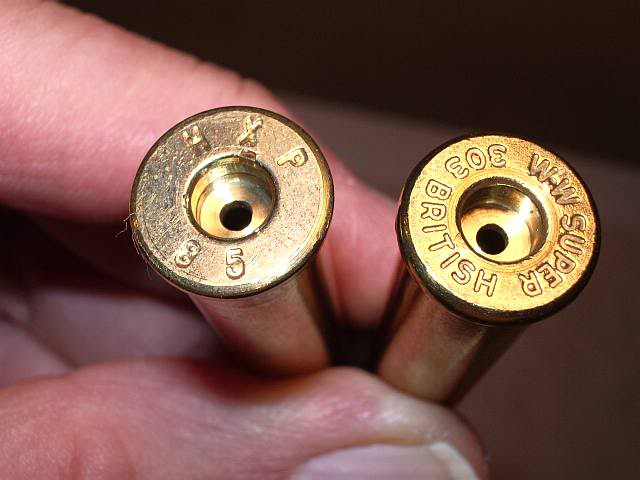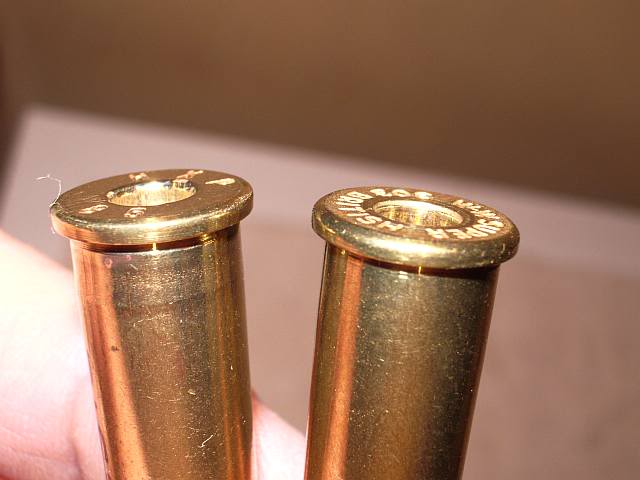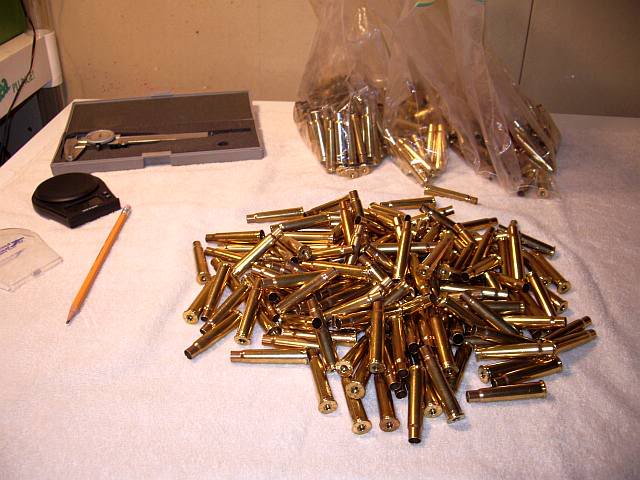-
Banned

I don't know if therre were two specifications for HXP ammo. One for the uk MoD and another for everyone else but that made for us was made to the tighest of controls and specification. It had to undergo exectly the same checks and controls as our previous RG and RL stuff. Which it did and there were few if any complaints about its performance.
We also used it in our machine guns too
We also had a huge (42,000?) round batch of Privi .303 1978 Mk7z ammo inspected, tested, analysed and approved in order to use it in Vickers guns. We still use some. And the Government Scientist who did the tests for us said that it conformed exactly to our approved standards in every respect.
That included rim tolerance, hardness of primer etc etc as does the UK MoD spec HXP.
So if you are using this stuff then from that, it equates to the usual old UK MoD spec stuff...............
The HXP I have, has a flat base solid lead core bullet and is loaded with Olin Ball type powder, its boxer primed not berdan primed.
Near as I can tell its identical to Winchester "Whitebox" generic .303 ammunition.
Is there a type of MkVIIz that does not in fact use the MkVII bullet?
Only British military .303 loaded with other than cordite that I've heard of was MkVIIz and MkVIIIz.
military .303 loaded with other than cordite that I've heard of was MkVIIz and MkVIIIz.
Also I've found that HXP ammo was produced under contract for the British government in the 80's but this appears to have been 7.62 NATO rather than .303.
-
10-28-2009 08:22 PM
# ADS
Friends and Sponsors

-
Legacy Member


Originally Posted by
Alfred

Also I've found that HXP ammo was produced under contract for the
British
government in the 80's but this appears to have been 7.62 NATO rather than .303.
I certainly have HXP brass in .303 dated from 73 and I think the last date I have of HXP is 86.
-
-
-
Banned


Originally Posted by
Strangely Brown

I certainly have HXP brass in .303 dated from 73 and I think the last date I have of HXP is 86.
Not much call for .303 in British service about that time, though I did see some photos of British troops carrying both the 7.62 BREN Guns and unaltered .303 BREN guns during the 80's, both gunners side by side during some operation.
service about that time, though I did see some photos of British troops carrying both the 7.62 BREN Guns and unaltered .303 BREN guns during the 80's, both gunners side by side during some operation.
I would think the British had more than enough .303 ammo in temperature controled storage, but use of the MkVII bullet at that late date might have raised eyebrows at the UN.
There are of course WW2 surplus .303 rifles in action every day in far flung corners of the world, and Vickers Guns are also still to be found.
The Indian Ordnance factory still manufactures MkVIIz ammunition for military contracts, and probably has a few Vickers and Bren Guns still in the original caliber.
Greek Powder and Cartridge would have had no shortage of customers other than the British.
If Radway Green stopped .303 production in the mid seventies they may have sold off remaining equipment to Greece.
PS
Just found a site that has Winchester WW2 rejected ammo found in a US Ordnance depot, story is this ammo, rejected by British Inspectors, was stored for use by US Coast Guard that had been issued Ross rifles.
The boxes are marked 174 grain "Full Patch" no mention of the MkVII bullet, so its likely this was the same solid core bullet used by the HXP ammo.
-
Banned

-
Banned

the HXP cases on average are 20 grains heavier than the Winchester cases and the rim of the Winchester is more rounded on the outer edge than the HXP cases.
And your cases are about thirty years apart in date of manufacture, one being from recent commercial manufacture, the other from WW2 era surplus machinery once used for military contracts.
I have an old commercial krag cartridge here whos rim is from .003 to .004 thicker than more recent production cases.
Commercial sporting rimmed ammo had thicker rims than much of the more recent production. Somewhere around here I have results of measuring the rims of a number of manufacturers, rim thickness usually at the max .064 or occasionally thicker by a few thou.
The .30-30 is a much lower pressure cartridge and rifles in that chambering aren't likely to have the generous headspace the Enfield is so well known for.
About the only things the two have in common is they are rimmed tapered cases. Might as well compare the 7.62X39 to the 7.62X25.
Winchester branded ammo can vary greatly in quality. I've had some that split lengthwise and the same type bought a year later that functioned perfectly.
I don't use Winchester cases any way I use Remington and have had no problems with those despite the thin rim, because I obtained a No.3 bolt head to get very a close head gap.
PS
Cartridge cases are not made to a single unalterable specification, Winchester Palma Match .308 cases weigh far less than other cases of the type, even other Winchester .308 cases.
There are variations over the years for one reason or another. On average a lighter case means more powder space and lower pressure for the same velocity.
External dimension must be very nearly the same, but internal dimensions are up to the load development department, to make the best use of available propellants and projectiles.
Also I just checked one of my Winchester "WW Super .303 British " cases, the rim looks nothing like the rounded rim of your cases.
" cases, the rim looks nothing like the rounded rim of your cases.
Aside from the headstamp this rim is identical to that of the HXP case you've pictured.
Theres a pretty detailed breakdown of the HXP .303 on this thread.
Surplusrifleforum.com • View topic - A look inside: .303 Greek HXP-71 ammunition
With plenty of big pictures like a certain someone likes to cover threads with, but these are informative.
More info
Carteach0: .303 British, cases before and after firing, comparison
Take notice of the visible difference in the relief cut above the rim, the two cartridges bear the same headstamp and year.
This suggests worn and rebuilt WW2 surplus machinery.
Figured I might as well add this
From a site discussing the various chamberings of the strengthened "Big Bore" Winchester rifles.
Let's assume the strength of the brass is the limiting factor in max pressures. Then consider that the area of a cartridge's base increases by the square and the circumference of the case increases in a linear fashion. The circumference of the case, together with case wall thickness, determines the cross sectional area of the brass available to resist the pressure. Thus the larger diameter case has less brass per unit of base area to contain pressure and so the larger diameter case will fail at a lower pressure than the smaller case.
The smaller diameter case puts less stress on the brass.
What I'd figured but this guy explained it well.
Last edited by Alfred; 10-29-2009 at 01:29 AM.
-
Moderator
(Lee Enfield Forums)


OK gang I think it’s time to let this one go. We have wandered way off topic here. The original title of the thread is “Enfield Headspace Issue” not “Here’s everything I think I know about 303 brass”. This thread was originally started back on 2007 and the question was answered back then. For NC Xplorer the correct answer to his question should be “take your rifle and reloads to a competent gunsmith and have them checked over”. Diagnosing issues like this one over the internet without so much as a photo of the items in question is almost impossible.
I don’t wish to lock this thread however I also won’t accept a rebuttal to this post. In honesty there is so much information on headspace available I don’t think anything of further value can be added to this thread.
-
Thank You to No4Mk1(T) For This Useful Post:
military .303 loaded with other than cordite that I've heard of was MkVIIz and MkVIIIz.















 Register To Reply
Register To Reply











